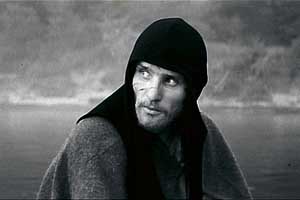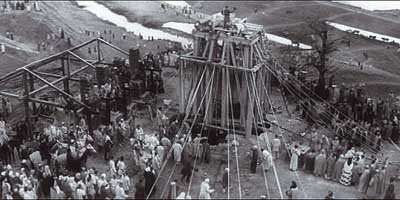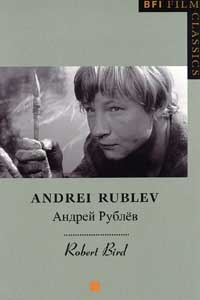Andrei Rublev: The study of a visually stunning movie, depicting that which cannot be filmed
By Jennifer CarnigNews Office
 A scene from the film Andrei Rublev, made by the late, Russian filmmaker Andrei Tarkovsky.  A scene from the film Andrei Rublev.  Christ the Savior by Andrei Rublev, ca. 1410 (Tretyakov Gallery, Moscow). | |
Apparently, Robert Bird likes a good challenge. An Assistant Professor in Slavic Languages & Literatures and the College, Bird is not primarily a film scholar—his expertise is actually Russian literature and thought—and yet his first published book is not about Dostoevsky or Florensky, but about Andrei Rublev, a 1966 movie made by Russian filmmaker Andrei Tarkovsky.
For the uninitiated, Andrei Rublev is every bit as challenging as any Russian literary volume, if not more so. Clocking in at three-and-a-half hours and full of strange, unsettling images, Andrei Rublev can be difficult to sit through. And yet when Bird first saw the film in 1989, while studying in Russia, he was mesmerized. “I’d never previously been much of a cinema fan,” Bird admitted, “but this struck me as more than a film. I was totally captivated—it was a profound experience.”
Bird is not alone in his admiration of the movie. The British Film Institute, the custodian of the world’s largest film archive and the publisher of Bird’s new book, simply titled Andrei Rublev, includes the film on its list of the top movies of all time. Each of the movies on the list is the subject of a book released through the Institute’s ongoing series BFI Film Classics, a collection of beautifully illustrated volumes of film history and analysis appropriate for film buffs and casual fans alike. Bird’s book joins the ranks of Camille Paglia’s treatise on Alfred Hitchcock’s The Birds, Salman Rushdie’s reflections on The Wizard of Oz, and a work on Ivan the Terrible by Yuri Tsivian, Professor in Art History and the College.
In addition to the British Film Institute’s seal of approval, Andrei Rublev also won the International Critics Prize at the 1969 Cannes Film Festival as well as several other festival nods.
Tarkovsky (1932-1986) is considered by many to be one of the greatest and most influential filmmakers in the history of the medium, though his work also is considered among the most enigmatic. His films are generally long and slow and follow unconventional narrative structures. Like War and Peace, Tarkovsky’s plots may seem foreign to a Western audience. They are “massive, complex narratives that make very few compromises,” Bird explained.
“Andrei Rublev is the most Russian of films, emblematic of what everyone finds so fascinating and so maddening in the way Russians do things,” Bird writes in the introduction to his volume. For more than three hours the title character does little more than observe. Much of the film is in fact devoted to a 16-year-long vow of silenceŠ“not an auspicious premise for a movie,” Bird continues.
But Tarkovsky’s work is visually stunning and carries with it the remarkable ability to convey atmosphere and mood. Andrei Rublev, Tarkovsky’s second film, is at once empty and dense, Bird said. Though ostensibly little happens, the film manages to depict the experience of religious belief without cheapening it.
“It is seen by its fervent admirers as the ‘film of films,’ putting it in the same category as the book of books—the Bible,” Bird writes. “But how can a film, which promises so much, possibly succeed while remaining a movie?” In his book, Bird tries to explain how the film succeeds as drama, even as it tries to transcend normal storytelling.
The film is a biography of sorts, as Andrei Rublev was a 15th-century monk regarded as Russia’s greatest icon writer. While his work is well known and celebrated throughout Russia, little is known of his life except for the handful of icons he left behind. Tarkovsky’s invented life for Rublev, Bird said, is then not an investigation into the painter’s life, but Tarkovsky’s response to what the filmmaker saw and felt by looking at Rublev’s icons.
“You can’t depict faith on film, so the whole film is about what cannot be shown,” Bird said. The filmmaker, he continued, attempts to bring the “mystery” of Rublev’s icons to life in his film.
Mystery may be the best word available to describe the film to Western audiences accustomed to an easy-to-follow plotline. Faith is not the only mystery—so is the narrative structure, the story of a painter never shown painting, as well as the main protagonist, who is little more than a peripheral character for much of the film.
Part of Bird’s project, then, was to contextualize the film by giving the audience a glimpse into the world in which Tarkovsky worked. In an attempt to explain “why this film can seem more powerful than the average film,” Bird excavates the filmic traditions of the time, the social reality of what life was like in the USSR and what he believes are the artistic movements of which the movie is a part.
Tarkovsky created a film about faith in a time when there were no films about religion, apart from satire or anti-religion propaganda. At the same time, people who were religious have tended to view film as a profane medium, inappropriate for religious topics.
The Soviet government was simultaneously waging a campaign to secularize Rublev’s work, turning him into a national hero instead of a church figure.
As Rublev’s icons were finally being preserved in museums and accepted as part of Russian history, churches closed all across the country.
Government censors edited and shelved Tarkovsky’s film once it was completed, and although it was shown in 1971, the film was not widely released in Russia until 1987, after perestroika was under way.
“Tarkovsky and his work can’t be pigeon-holed,” Bird said. “He was not a dissident, but he was not pro-Soviet. He was just Tarkovsky, one of the only truly independent artists in the country.”
Andrei Rublev is an important cultural artifact to view and study for its literary and artistic value, Bird said. “To understand why this is such an amazing film, one must contextualize it in its period,” he said. “It’s a completely unique film.”
Bird is currently working on another book on Tarkovsky, tentatively titled Andrei Tarkovsky: Elements of Cinema, in which he studies the filmmaker’s entire body of work. He also is writing a book entitled Suspense.
Both projects are part of Bird’s larger interest in the tradition of uneventful narratives in Russian literature and film and how they communicate the atmosphere and mood of a story.
![[Chronicle]](/images/sidebar_header_oct06.gif)